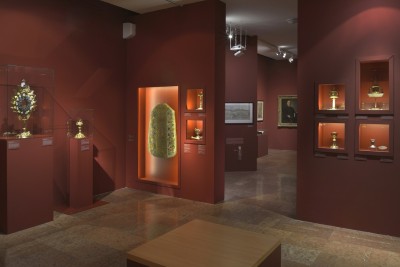- Hitre, tudásra: A piaristák és a magyar művelődés
(Budapesti Történeti Múzeum, Vármúzeum, 2017. november 15.–2018. február 28.)
|
A templomok sekrestyéje csomópont és bázis, a papi és a lelkipásztori szolgálat kiindulópontja. A piaristák nem csak tanárai, hanem papjai is diákjaiknak, és biztosítják számukra az egyház szentségeit. A piarista iskolához hozzátartozott a napi szentmise és a rendszeres gyónás, a korok változó szokása szerint. Az 1920-as években Sík Sándor (1889–1963) közvetlenségének egyik „jellemző szimbolikus gesztusa volt, hogy szakítva az akkor általános gyakorlattal … nem a katedrán gyóntatott, hanem lejött a padok elé, s úgy hajolt szeretettel a mellé térdelő diák fölé.” A piaristák sok régi diákjuk házassági szertartását végezték, és néha szomorú kötelességük volt elhunyt kisdiákjaik eltemetése is. Nem ijedtek meg a plébánosi, sőt misszionáriusi munkától sem, amikor a 17. századi, protestáns többségű Magyarországon arra volt szükség. |
The sacristy of churches is a node and a base, the starting point for priestly and pastoral ministry. The Piarists are not only teachers but also priests of their students and they provided them with the sacraments of the Church. Daily mass and regular confession formed part of the Piarist curriculum, according to the changing habits of the ages. In the 1920s, one of the symbolic gestures of Sándor Sík (1889–1963) was that “he left the general practice of confessing on the platform of the classroom, but came down to the desks and leant with fondness over the student kneeling beside him.” The Piarists performed the marriage ceremonies of many of their old students, and sometimes it was their sad obligation to bury the young students who died. They were not afraid of parochial or even missionary work when it was needed in the 17th century Hungary, where Protestants were in majority. |
Lelkipásztori munkát végző piaristákról készült fényképek
